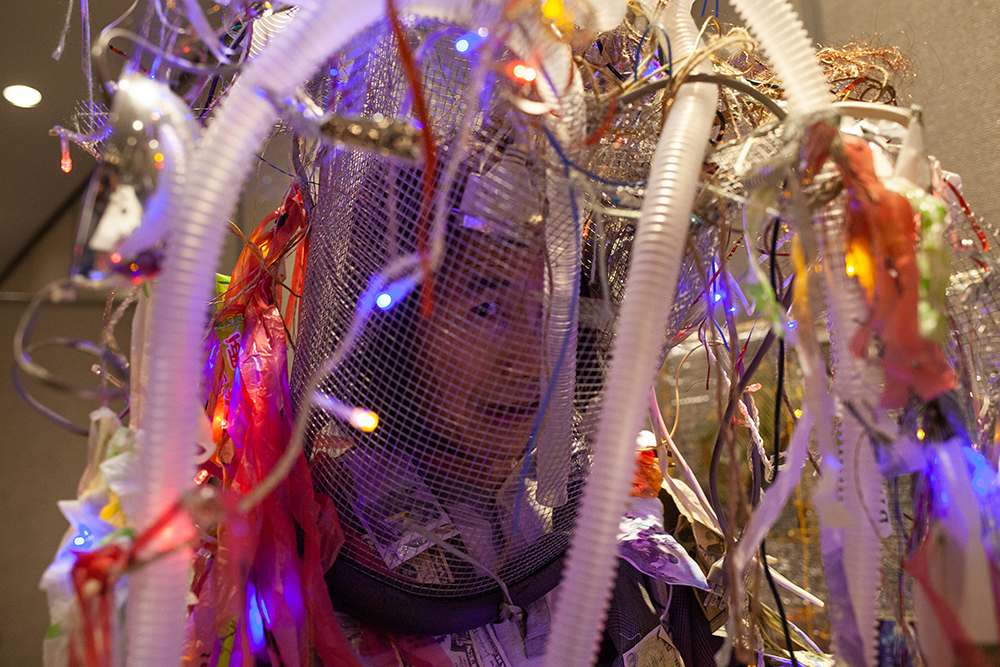CAA News Today
Submit Your Proposal for Graduate Screenings at the 2021 Annual Conference
posted by CAA — September 22, 2020
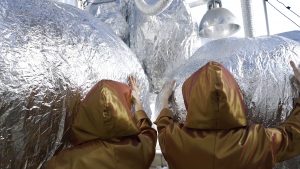
Film still from Tending Breadth (2019), courtesy of Heather Taylor and Jacklyn Brickman
CAA’s Services to Artists Committee (SAC) invites current graduate students (or 2020 graduates) to submit work for consideration in the 2021 Graduate Screenings: Film/Video, Animations, & New Genres program for the upcoming 109th Annual Conference in February 2021. For the conference, SAC will screen the selected winners online.
Through this screening and exhibition initiative, SAC aims to give the next generation of artists and practitioners an opportunity to display their work in a national forum. Our annual Graduate Screenings celebrates the hard work of graduate students across the nation and world, while exposing their artworks to a broad audience. We look forward to reviewing your submission.
Eligibility
Applicants must be enrolled currently in an MFA (or equivalent MA or PhD) program OR have graduated from a program in the spring or summer of 2020. Due to the university shutdowns in the spring of 2020, SAC will accept submissions from recent 2020 program graduates.
Please use the form below to submit your entry. Submission for consideration is free and membership with CAA is not required (we are collecting this information for statistical purposes). All videos must follow the specifications and meet all technical requirements or they will not be accepted.
SAC Jurors
Farhad Bahram, Indiana State University; Robert Howsare, West Virginia Wesleyan College; Sue Huang, University of Connecticut; Richard Serrano, Art This Week Productions
Guest Juror
Ugochukwu-Smooth C. Nzewi, the Steven and Lisa Tananbaum Curator, Department of Painting and Sculpture at the Museum of Modern Art (MOMA)
Invited guest juror Ugochukwu-Smooth C. Nzewi will select one work from the SAC juried program to be awarded best in show.
Contact: servicestoartists@gmail.com; please include “Graduate Screening Question” in the subject line if you have a question
Deadline for submission: December 4, 2020
Acknowledgment of submission selection: January 19, 2021
Submissions Items for Application Form Input:
—First and last name
—Name of school and department
—Degree (MFA, PhD or MA) and major/concentration
—Year of graduation
—CAA member status (it is not required to be a member)
—If member, CAA membership number
—Narrative bio
—Artist statement
—Personal website (optional)
—Vimeo link (see specs below)
—Film still from your video to be used for promotion purposes (see specs below)
Video/Image Submission Specifications:
Please note that submissions missing any of the below specifications may be disqualified from consideration.
Video:
—5 minutes in maximum length (excerpts accepted)
—H.264 at 1920 x 1280px (MP4 file format)
—Include 2 opening title cards:
—1st card–5 seconds; include your full name (first and last), title of work, year of completion, name of school, department and/or program
—2nd card–5 seconds; include credits for music, sound, other camera people, editing. Even if these were you, include these credits
—Upload submission to Vimeo.com (include your link. Video must remain viewable on Vimeo until February 9th). —Selected participants will be required to upload their hi-res video file to a Google drive in late January and maintain their video on Vimeo till the end of the conference
Image:
—Still from video submission
—960 x 640px (landscape), 72 dpi (JPG file format)
Submit Your Proposal for ARTexchange at the 2021 Annual Conference
posted by CAA — August 27, 2020
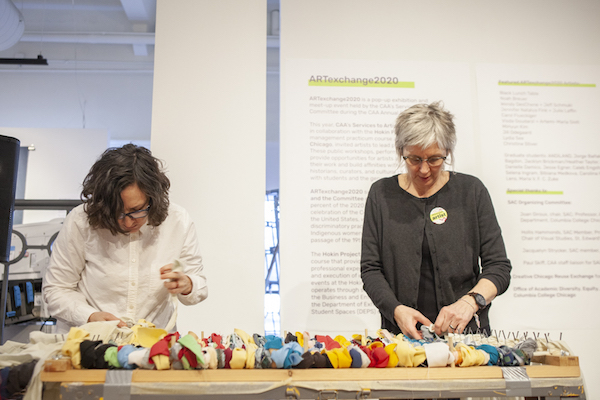
A participant and artist Jill Odegaard work on Woven Welcome as part of ARTexchange at the 2020 Annual Conference in Chicago. Photo: Stacey Rupolo
CAA’s Services to Artists Committee seeks proposals for interactive and participatory projects and/or workshops for CAA’s 2021 ARTexchange.
Originally formatted as a pop-up exhibition and meet-up event for artists and curators, ARTexchange provides an opportunity for artists to share their work and build affinities with other artists, historians, curators, and cultural producers.
This year, the Museum of Arts and Design (MAD) will host ARTexchange on Saturday, February 13, 2021, for a day of interactive and participatory projects and/or workshops.
ARTexchange projects and/or workshops will take place in MAD’s theater. The museum is located on Columbus Circle, just a short walk from the New York Hilton Midtown.
Safety permitting, projects will be available for in-person participants/viewers, as well as live streamed, and/or made available for online participation. Proposals that include community engagement and meaningful interaction with the CAA and New York City communities will be prioritized.
The Services to Artists Committee encourages applicants to engage issues of inclusivity and intersectional discourses in the arts. As part of the 2021 Annual Conference, CAA seeks to offer a selection of programming on the topic of Climate Crisis, including but going beyond eco-art and eco-criticism, and with climate justice and intersectional thinking as priorities. The conference content will stress a broad and inclusive conversation on climate crisis impact through the lens of age; gender; nationality; race; religion; and socioeconomic status among others. The Services to Artists Committee encourages ARTexchange proposals that respond to this call for content, though we will also consider proposals beyond its scope.
Please consider that activities may take place in a public, open, non-studio environment, and should not include toxic materials or processes.
Please email any questions to servicestoartists@gmail.com. Include “CAA ARTexchange” in the subject line.
Proposals are due by November 9, 2020 (extended deadline).
You will be asked to provide:
- Contact information
- A short narrative bio (up to 150 words)
- A short artist statement (up to 150 words)
- Website url (optional)
- A PDF (one file maximum 10 MB) of your proposal detailing your project, including supporting images, materials requests, technical needs, and how you will engage the community and/or consider inclusivity through the proposal. (up to 500 words)
- Work samples (5–10 images and/or links to 1–2 video/audio files)
- An image description list detailing the title, year completed, medium, and dimensions of each work. You may also include a short description describing how the work relates to the proposed project.
- A 50 word description of your proposed project that can be used in publications
- Availability: do you plan to be in NYC during the 2021 Conference, or will your project be presented in a fully virtual format
International News: “My World Now Is Black in Color:” Pandemic-Era Programming, Anti-Racist Activism, and Contemporary Art in Italy
posted by CAA — August 11, 2020
The following article was written in response to a call for submissions by CAA’s International Committee. It is by Tenley Bick, Assistant Professor of Global Contemporary Art, Department of Art History, Florida State University, and the 2019–20 Scholar in Residence at Magazzino Italian Art Foundation, New York. A related essay, “Ghosts for the Present: Countercultural Aesthetics and Postcoloniality for Contemporary Italy,” will be included in an edited volume forthcoming from Lexington Books.
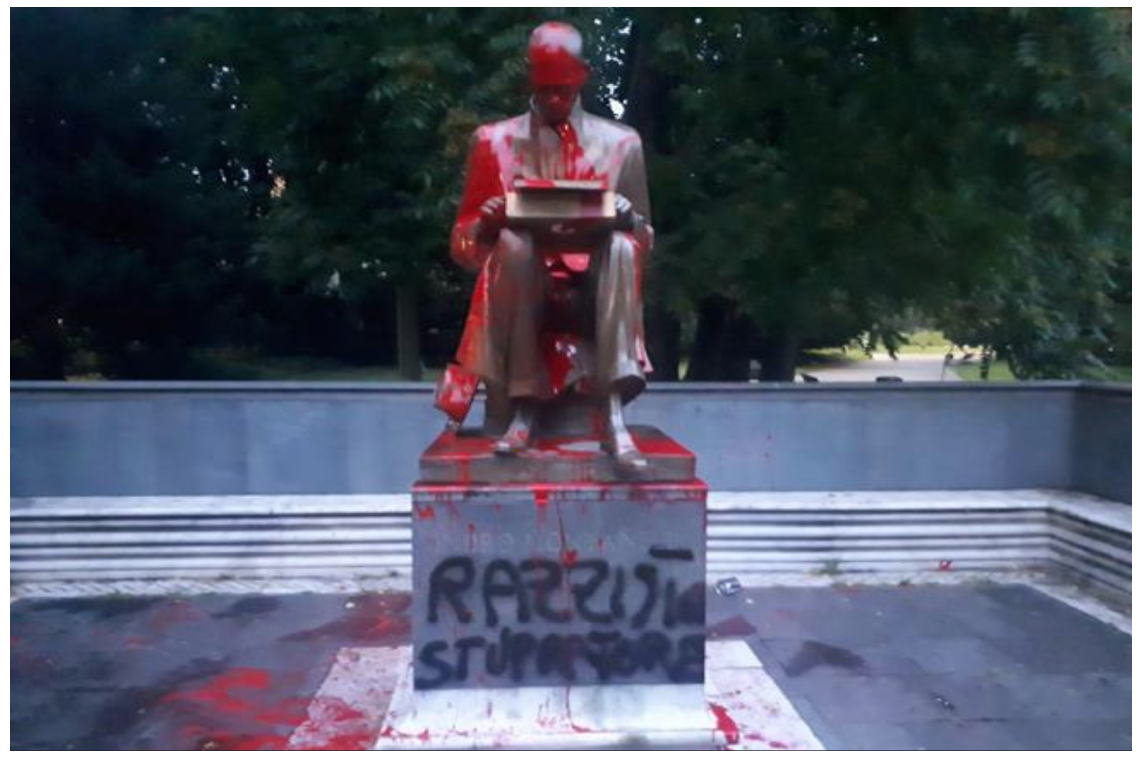
Figure 1. “Indro Montanelli, imbrattata la statua a Milano” (Indro Montanelli, statue smeared in Milan). Corriere della Sera, June 13, 2020 (https://www.corriere.it/cronache/20_giugno_13/indro-montanelli-statua-imbrattata-81a5c120-adad-11ea-84a7-c6d5b5b928b0.shtml). Photo: AP
June 13, Milan. The 2006 monument to Italian journalist Indro Montanelli was found covered in red paint and tagged “razzista, stupratore”: racist, rapist. The intervention targeted the statue of Montanelli and the journalist’s past as a colonial soldier in East Africa. In 1935, Montanelli bought a twelve-year-old Eritrean girl, Destà, to serve as his wife under the practice of madamismo. Montanelli never apologized. The intervention ignited public debate in Italy on racism and public monuments, bringing the country popularly known for apathy toward its colonial and fascist histories, pervasive associated monuments and street names into renewed transatlantic debates on these topics. Four days prior, Italian-Somali writer Igiaba Scego, writing on anti-Black racism, Black Lives Matter, and monument debates in the United States and Europe in the Italian weekly Internazionale, made a call for Italy to confront the “uncomfortable traces of our past.” Citing an earlier intervention at the Montanelli monument in 2019, Scego noted the absent memorialization of Destà: “It would be nice if someone, whether a street artist or a municipality, dedicated a statue, a drawing, a memory to that distant child” (trans. Bick). Street artists and activists responded (Figs. 2–3). Cities did not. The Montanelli monument was cleaned and, by mayoral decision, remains in place.
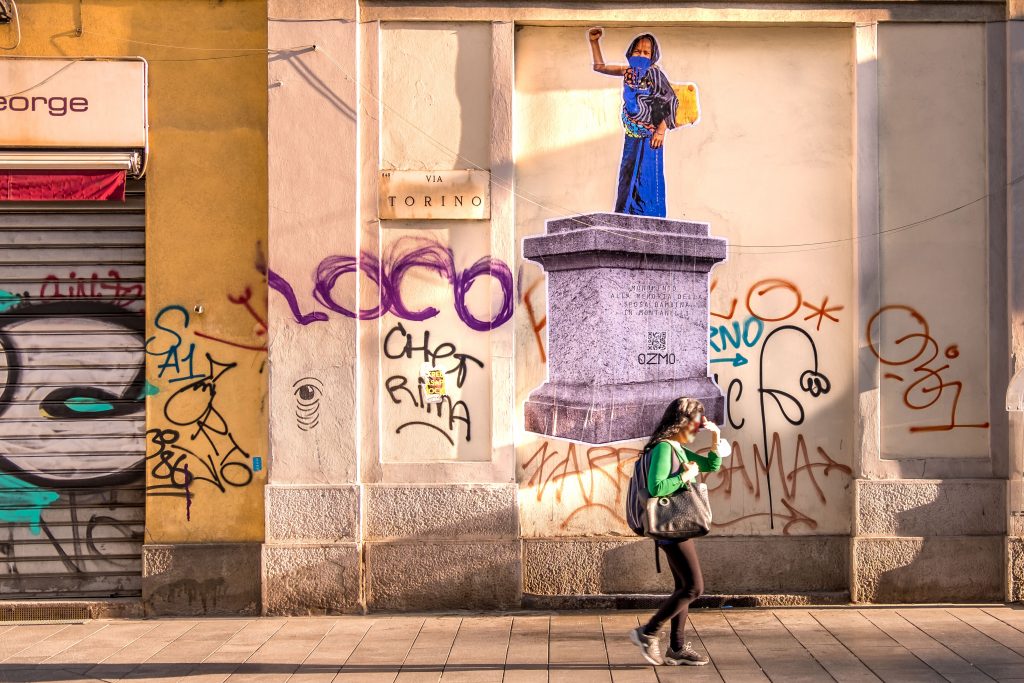
Figure 2. In Milan, Italian street artist Ozmo’s mural depicts a fictional monument to Destà, the Eritrean child “bride” of Indro Montanelli, when the famous journalist was a colonial soldier. Working specifically in response to Igiaba Scego’s call, the artist used a photo of a contemporary Eritrean girl of approximately the same age as Destà upon her “marriage,” to stand defiantly in place of Montanelli on the base of his monument, relabeled in memory to “Montanelli’s child bride” (IG @ozmone, June 15). The mural was vandalized within two days. Inkjet on blueback paper, measurements to site (dimensioni ambientali). Photo by Gianfranco Candida, @wallsofmilano. Courtesy of Ozmo.
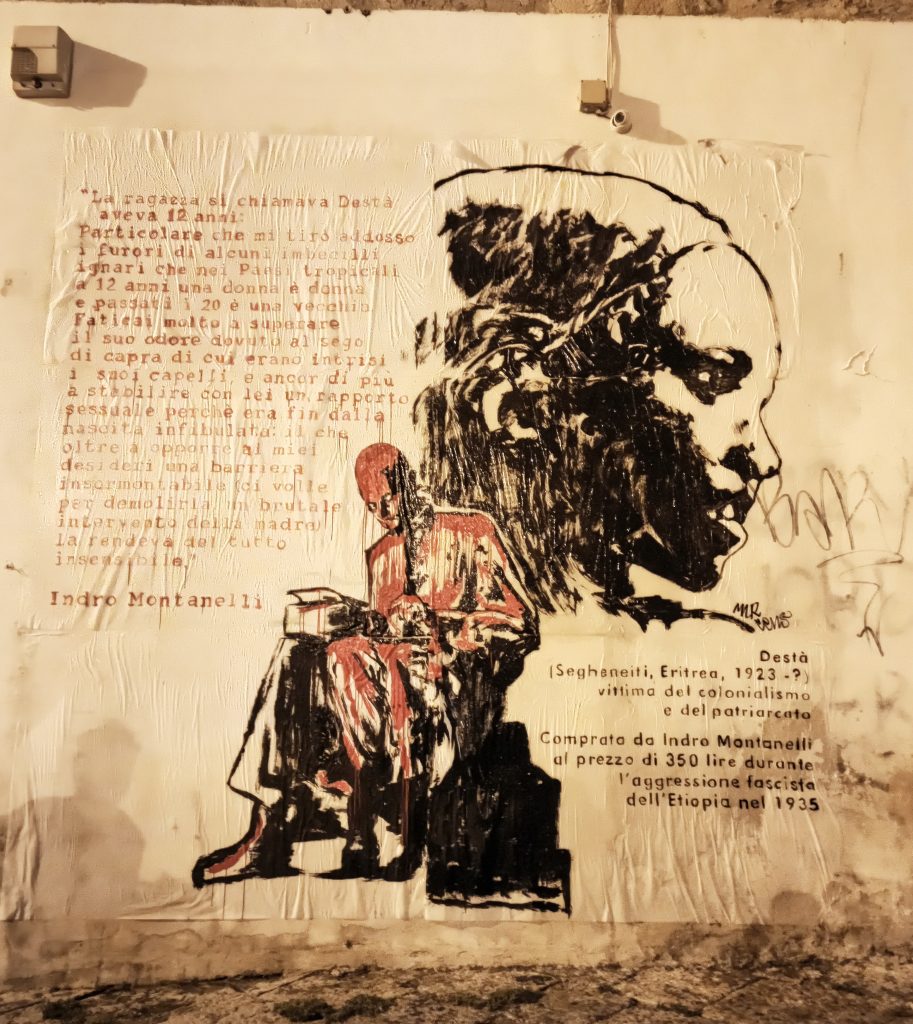
Figure 3. In Palermo, artists Mr. Cens, Betty Macaluso, and Ulrike conceived the mural depicting the vandalized monument to Montanelli and a portrait of Destà. Mr. Cens executed the large public mural. Acrylic on tissue paper, 9.8 x 9.8 ft. (3 x 3 m). Palermo, June 16, 2020. Courtesy of Mr. Cens. The mural builds upon a 2018 work by Wu Ming 2 (Giovanni Cattabriga) and Palermo-based artist collective Fare Ala (Luca Cinquemani, Andrea Di Gangi, Roberto Romano), Viva Menilicchi!, which temporarily renamed via Montanelli “via Destà.”
One of the first hotspots in the COVID-19 pandemic, Italy was then emerging from a three-month lockdown. During that time, Italian museums (public and private) became leaders in innovative arts programming for a pandemic-era world. The Museo Madre launched an #iorestoacasa “call to action” campaign, publishing artists’ responses to the pandemic online; the Galleria Nazionale d’Arte Moderna invited and posted videos about its permanent collection; the Fondazione Prada produced podcasts and alternative exhibition encounters through its #innerviews and #outerviews programs, using social media as a “laboratory” for “new formats and codes” (@FondazionePrada, Mar. 18). This innovation has since extended to safety technology. Florence’s Museo dell’Opera del Duomo introduced wearable sensors to ensure social distancing—technology subsequently implemented by institutions of Italian art outside of Italy. Magazzino Italian Art Foundation (New York) is the first museum in the United States to use the technology, reopening with Homemade (cur. Vittorio Calabrese with Chiara Mannarino), an exhibition of work made during the pandemic by New-York-based Italian artists.
While the Montanelli debate coincided with a moment of reckoning for institutions in the United States and Western Europe, the overwhelming majority of art museums in Italy have not announced such programming, policy changes, or statements of solidarity. This inattention is not due to a lack of anti-racist social justice activism in Italy (Black Lives Matter Roma, Neri Italiani, the Stati Popolari movement, among others), nor is it due to an absence of Black Italians in Italian popular culture, especially in literature (Scego), cinema (Fred Kuwornu, Amin Nour), and music (Ghali).
A few exceptions demonstrate the potential for institutionally supported, sustained, collaborative programs to counter anti-Black racism in Italy. The Uffizi has partnered with Black Lives Matter Florence on a series of virtual programs to address “the presence of black culture in European art, told through the works of the Gallerie degli Uffizi” (https://www.uffizi.it/video-storie/black-presence). Organized by Justin Randolph Thompson, co-founder and director of Black History Month Florence (BHMF), in collaboration and partnership with the Uffizi as part of their On Being Present program, the eight-week series entitled “Black Presence” debuted July 4th with Thompson’s video discussion of a Piero di Cosimo work and continues with concerts and video tours on representations of Black Africans in Renaissance art. MAXXI, one of Italy’s major contemporary museums, launched a short-lived social media initiative: #MAXXIforblacklivesmatter. The campaign “aims in raising awareness and consciousness of the @blklivesmatter movement through art” (@museomaxxi). With eighteen tagged Instagram posts (most recently dated June 17), the museum posted images of BLM protests in Italy and works by African and African diaspora artists Robin Rhode, John Akomfrah, and Yinka Shonibare from MAXXI’s 2018–19 exhibitions. The initiative was highlighted on June 12 by Italian-Haitian-Ghanaian cultural curator and Griot founder Johanne Affricot in an essay for Artribune as a “necessary” if late action amidst the generally delayed response from arts and culture in Italy to BLM in comparison to the global context (“Black Lives Matter ma non in Italia. Il ritardo dell’arte e della cultura nel paese,” June 12). Program information is notably no longer available on MAXXI’s bio.
Beyond these varied efforts, Black artists have been included in major museum and gallery exhibitions, and Black curators have curated exhibitions at prominent museums, but these figures are almost always non-Italian artists and art workers. While Italy is becoming increasingly multi-ethnic (and multi-racial), the country does not track ethno-racial statistics (Reynolds 2018, BBC; Ambrosetti and Cela 2015). Instead, citizenship and place of birth serve as “proxies” for race and ethnicity (Ambrosetti and Cela 2015). This is one of many reasons—from racial laws under fascism to renewed racism in response to cross-Mediterranean migration—why Blackness in Italy is most associated with foreign identity (with populations of African migrants, immigrants, and residents) rather than with Italian identity as well.
Two Afro-Italian artists—Jem Perucchini (b. 1995) and Luigi Christopher Veggetti Kanku (b. 1979), both based in Milan—are making inroads that might change that. Perucchini made a series of portraits of Black Italians in history for Vogue Italia during Black History Month (see Jordan Anderson, Mar. 12, 2020) (Fig. 4).
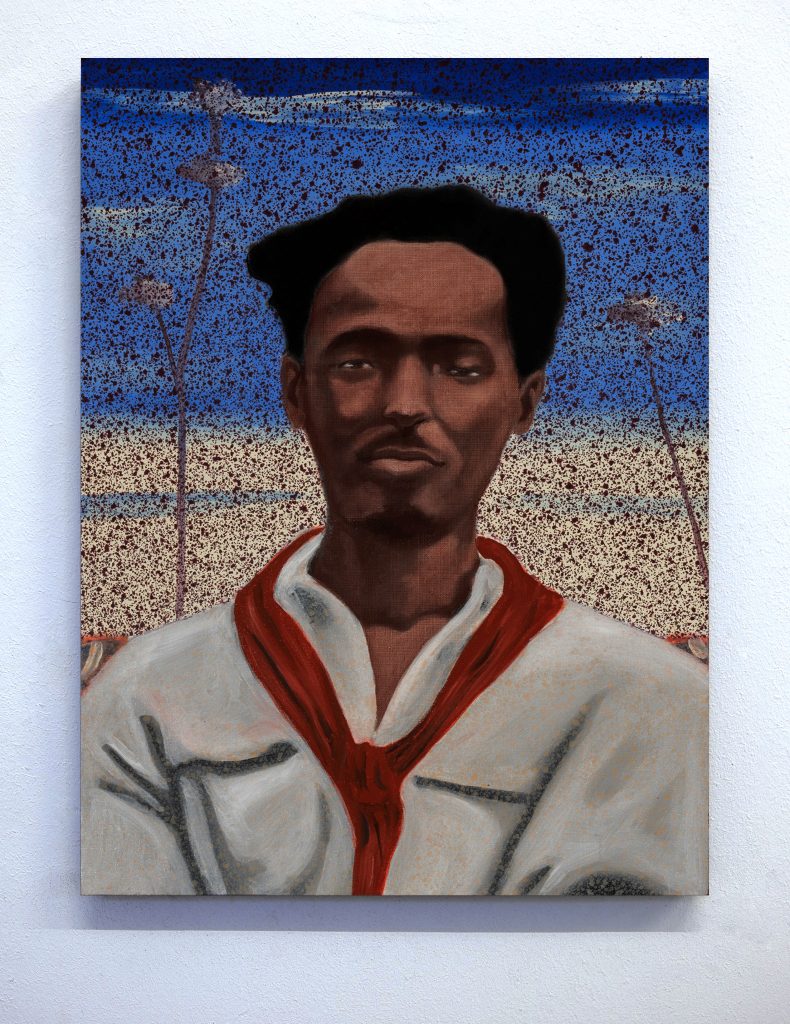
Figure 4. Jem Perucchini’s Alessandro Sinigaglia (2020) depicts a little-known Black, Jewish Italian member of Italy’s anti-fascist resistance during World War II. Oil on linen, 15.75 x 12 in. (40 x 30 cm). Courtesy of Jem Perucchini.
Harper’sBazaarTV followed with a “visual interview” in mid-July. When asked “What colour is your world, these days?” the Ethiopian-Italian artist responded: “Certainly my world now is black in color. I think it is the color that is most suited to represent the situation that the whole world is experiencing, in terms of sanitary, economic, social problems” (interview by Laura Taccari, trans. Bick). At the end of lockdown, Perucchini had completed a large painting of the Stele of Axum: the ancient obelisk that Italy returned to Ethiopia in 2005, nearly seventy years after stealing it as war spoils (Zoom interview with Bick, Fig. 5).
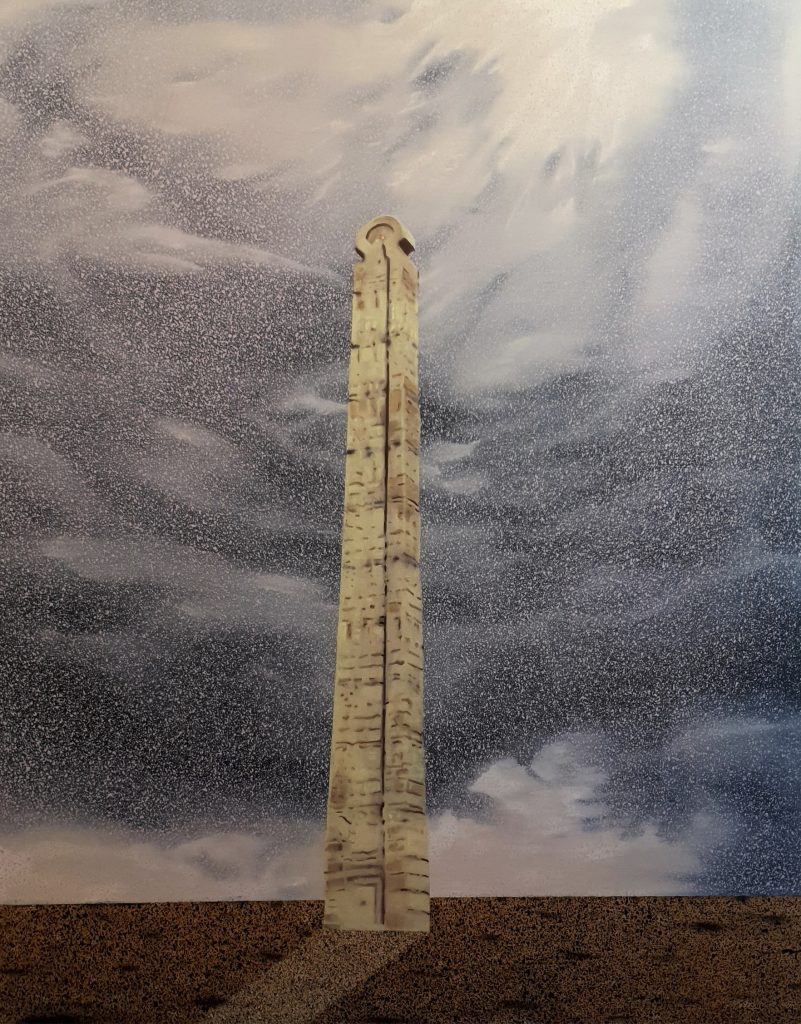
Figure 5. Jem Perucchini, Axum, 2020. Oil on linen, 55 x 43 in. (140 x 110 cm). Courtesy of Jem Perucchini. Completed during the lockdown, Perucchini’s Axum depicts the fourth-century stele that was taken as war spoils during Italy’s second colonial invasion of Ethiopia. The stele remained on display in Rome for nearly seventy years.
Veggetti Kanku (represented by Galleria Rubin, Milan) has confronted the institutional and cultural marginalization of Black people in Italy directly. In late June, the Congolese-Italian artist held a soft opening of a new exhibition space in Milan’s center for Afro-Italian artists (Zoom interview with Bick, Jun. 29). Entitled The Office, the evenings-and-weekends-only arts space is a legal office during regular business hours. Veggetti Kanku’s monumental portraits of Black women (Fig. 6), intended to bring Black figures into (white) Italian bourgeois homes (Griot, Mar. 25; Zoom interview with Bick), hang in the space, to be inaugurated this fall with his solo show SOTTOPELLE: “A show dedicated to black women, inclusive of social status, a show that destabilizes and puts up for discussion the canons of strictly Western beauty in an ever-increasing multi-ethnic Italian reality” (Veggetti Kanku, email correspondence with the author, July 16, trans. Bick).
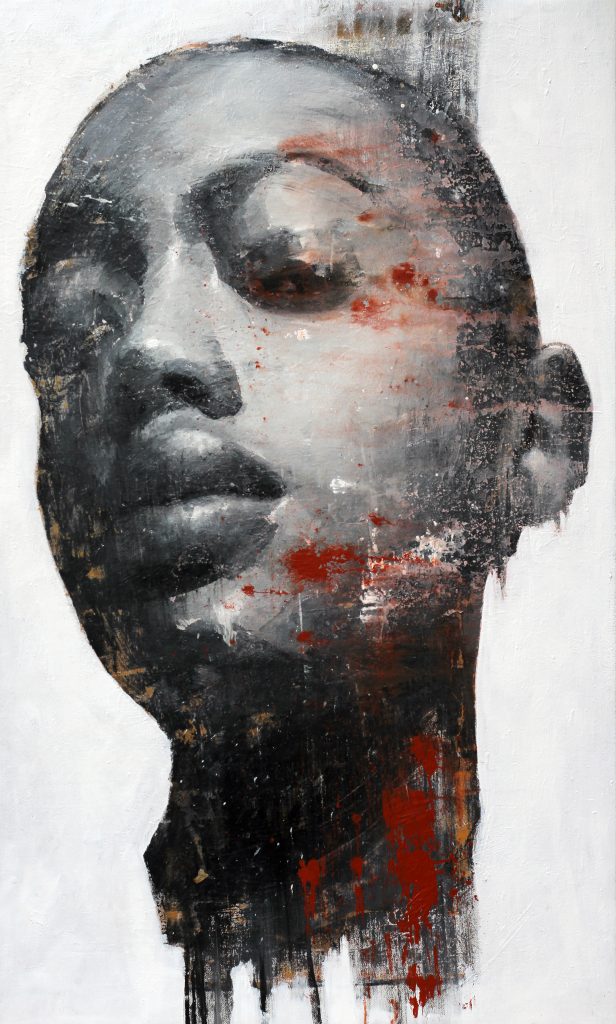
Figure 6. Luigi Christopher Veggetti Kanku, Untitled, 2020. Oil and acrylic on canvas, 65 x 39 in. (165 x 100 cm). Veggetti Kanku’s monumental portraits of Black women will be exhibited in his solo show, SOTTOPELLE (UNDERSKIN) at his new space for Afro-Italian artists, The Office, located in the center of Milan.
The museum complex now perhaps most directly engaged with Italy’s colonial history, the Museo delle Civiltà (home to Italy’s national ethnographic museum and partial repository of Italy’s colonial collection, formerly at the Museo Coloniale di Roma and various iterations that followed), has announced plans for a new museum (in development since 2017) dedicated to Italian colonialism in Africa (including postcolonial periods and an engagement with contemporary art): the Museo Italo-Africano Ilaria Alpi, to open in 2023. (See Scego, and Giulia Grechi and Viviana Gravano’s interview with colonial collections’ curator and cultural anthropologist Rosa Anna Di Lella in Roots–Routes). As Italy begins to address the presentness of its colonial past, the absence of Black Italian artists in Italy’s museums and galleries persists. What might a Perucchini or Veggetti Kanku exhibition look like at MAXXI or the Galleria Nazionale? What might happen if the innovation of Italian arts programming and centrality of the arts to Italian identity made space for the multi-ethnicity of Italy today? It remains to be seen if and how the country’s art museums and galleries—leaders in arts programming in many ways—will address racial inequity in their own collections.
You’re Invited: Envisioning the Future of Higher Education in the Arts
posted by CAA — August 03, 2020
Tuesday, August 18, 2020
2 PM – 3:15 PM (ET)
RSVP HERE
Hosted by Art World Conference
Facilitator: Natalia Nakazawa, Artist, Arts Administrator, and Educator
Participants: Deborah Obalil, President and Executive Director of AICAD; Meme Omogbai, Executive Director and CEO of CAA
In 2020, colleges and universities across the world have rushed to adapt to a new reality that questions the very nature of their work: a pandemic sent students home and protests shone a spotlight on inequality supported by many of our institutions, including those in higher education. Since March, everyone involved in education has had to rethink fundamentals and challenge core assumptions ranging from the format of instruction to what and who creates value. Since arts education is historically vulnerable to funding cuts and much of the instruction relies on hands-on studio classes, specialized equipment, in-person mentorship, and tuition dollars, the systemic changes necessary to thrive require radical, ethical thinking. What are the responsibilities and priorities being considered going into this exceptional academic year?
Artist and educator Natalia Nakazawa will facilitate a discussion between two important leaders in arts education: Deborah Obalil, the President and Executive Director of the Association of Independent Colleges of Art and Design (AICAD), and Meme Omogbai, the Executive Director and CEO of the College Art Association (CAA). Both institutions support and advocate for artists, arts workers, and scholars in the art and design fields. Together, they will discuss the evolving paths forward for higher education in the arts, including structural changes and very significant challenges. What is the role of higher education in times of crisis? Since creativity is nurtured by the institutions they oversee, what are the creative solutions being implemented to address health concerns, anti-racism efforts, adjunct culture, and affordability? What are their hopes and expectations for the future?
This 75-minute webinar is designed with everyone in the art world from current students to artists, arts administrators, and art historians in mind. Questions submitted during registration will be incorporated into the discussion as appropriate.
PARTICIPANT BIOGRAPHIES
Natalia Nakazawa is a Queens-based interdisciplinary artist working across the mediums of painting, textiles, and social practice. Utilizing strategies drawn from a range of experiences in the fields of education, arts administration, and community activism, Nakazawa negotiates spaces between institutions and individuals, often inviting participation and collective imagining. She has held the position of Assistant Director of EFA Studios for over 8 years, supporting a large network of contemporary artists through subsidized studio spaces and professional practice opportunities in midtown Manhattan. Nakazawa received her MFA in studio practice from California College of the Arts, a MSEd from Queens College, and a BFA in painting from the Rhode Island School of Design. Her work has recently been exhibited at Wave Hill (Bronx, NY), Arlington Arts Center (Washington, DC), Transmitter Gallery (Brooklyn, NY), Wassaic Project (Wassaic, NY), The Old Stone House in Brooklyn (Brooklyn, NY), and The Metropolitan Museum of Art (New York, NY). Nakazawa has been an artist-in-residence at MASS MoCA, SPACE on Ryder Farm, The Children’s Museum of Manhattan, and Wassaic Project. She teaches at CUNY.
Deborah Obalil has over twenty years experience as a leader in the national arts and culture industry. She was appointed the Executive Director of the Association of Independent Colleges of Art & Design (AICAD) in June 2012, and then President in the fall 2015. Prior to her appointment with AICAD, Obalil operated a successful boutique arts management consulting firm, Obalil & Associates for four years. The firm provided consultation and facilitation in strategic business planning, marketing research and planning, and board development for non-profit arts organizations, independent artists of all disciplines, and creative for-profit ventures. Obalil has also served as Executive Director of the Alliance of Artists Communities and Director of Arts Marketing Center & Research at the Arts & Business Council of Chicago.
Meme Omogbai is Executive Director and CEO of College Art Association (CAA), the preeminent international support organization for professionals in the visual arts. Before joining CAA, Omogbai served as a member and past Board Chair of the New Jersey Historic Trust, one of four landmark entities dedicated to preservation of the state’s historic and cultural heritage and Montclair State University’s Advisory Board. Named one of 25 Influential Black Women in Business by The Network Journal, Meme has over 25 years of experience in corporate, government, higher education, and museum sectors. As the first American of African descent to chair the American Alliance of Museums, Omogbai led an initiative to rebrand the AAM as a global, inclusive alliance. While COO and Trustee, she spearheaded a major transformation in operating performance at the Newark Museum. During her time as Deputy Assistant Chancellor of New Jersey’s Department of Higher Education, Omogbai received Legislative acknowledgement and was recognized with the New Jersey Meritorious Service Award for her work on college affordability initiatives for families. Omogbai received her MBA from Rutgers University and holds a CPA. She did post-graduate work at Harvard University’s Executive Management Program and has earned the designation of Chartered Global Management Accountant. She studied global museum executive leadership at the J. Paul Getty Trust Museum Leadership Institute, where she also served on the faculty.
In Memoriam: Cynthia Navaretta
posted by CAA — June 15, 2020
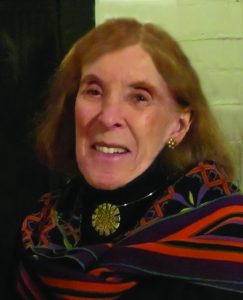
Cynthia Navaretta.
We were saddened to learn of the passing of critic, publisher, and longtime CAA member Cynthia Navaretta last month at the age of 97. An active member of the organization and a founding member of the Women’s Caucus for Art (WCA), Navaretta was founder of the feminist arts publisher Midmarch Arts Press and a tireless advocate for women artists.
A memorial in her honor will be hosted via on Sunday, September 13th, 2020, at 6pm (EST). Members interested in attending are invited to contact cyncelebration@gmail.com to receive information and a link closer to the event. Readers are also invited to post comments and pictures about her life on a newly created Facebook page, here.
Cynthia Navaretta, art critic, curator, publisher, art collector, architectural engineer died on May 18, 2020 at 97
In her mid-twenties Cynthia Navaretta was immersed in the New York art scene from the early days of the ‘New York School’ and the influential “8th Street Club” (one of only 6 female members!) before she married Emanuel Navaretta, artist, poet, critic, professor and roommate of Franz Kline in 1950. Cynthia’s friends and neighbors in New York and Long Island (Springs in the Hamptons) included Jackson Pollack, Harold Rosenberg, Lee Krasner, Milton Resnick, Milton Avery, Franz Kline, the De Kooning’s (Elaine and Willem) Ibram Lassaw, David Smith, Phillip Pavia, Judy Chicago, Agnes Martin, Pat Passlof, Hans Hofmann, June Wayne, Susan Schwalb and a long list of other art legends.
In 1974, she was a founding steering committee member of ‘Artists Talk On Art’, the art world’s longest running panel discussion series. With her knowledge of the New York art scene, along with her professional qualifications in engineering and building, Cynthia served as a mayoral appointee to the Artists Certification Committee of the NYC Department of Cultural Affairs and later served as the public voting member of the powerful Loft Board in Manhattan for 20 years, deciding who was a bona fide artist and deserving of live-work studio space in converted factories. She was a founding member of the Women’s Caucus for Art, the Coalition of Women’s Arts Organizations, and also Women in the Arts.
She represented the United States at the 1985 UN Conference on Women in Kenya and served in similar capacities on other boards and meetings around the world including the International Festival of Women Artists, Copenhagen in 1980. She befriended many well-known African-American women artists throughout the United States. In 1995, she published the first definitive compendium of American women artists of color – Gumbo Ya Ya: Anthology of Contemporary African – American Women Artists with an introduction by Leslie King Hammond, Midmarch Arts Press.
As the founder of Midmarch Arts Press, she published numerous memoirs, guides, histories and anthologies by and about American artists, male and female including: Guide to Women’s Arts Organizations, Women Artists of the World edited by Sylvia Moore, Cindy Lyle and Cynthia Navaretta, Mutiny in the Mainstream — Talk That Changed Art (with Judy Seigal), The Heart of the Question, The Writings and Paintings of Howardena Pindell, introduction by Lowery S. Sims, Voices of Women, by Lucy Lippard, Postmodern Heretics, by Eleanor Heartney, Out of the Picture: Milton Resnick and the New York School edited and with an Introduction by Goeffey Dorfman and The First Wife’s Tale: A Memoir by Louise Strauss – Ernst, to name only a few.

Cynthia Navaretta at the National Women’s Conference in Houston 1977. Credit: Judy Seigel, via The New York Times
Her sharp mind, mixed with her organizational skills and ability to span many spheres of knowledge and personalities made her the ideal art panel planner, moderator or guest speaker. She was a beloved panel participant at College Art Association and mentored many young female artists. She was an active member of the International Art Critics Association and often traveled on their numerous trips around the world. She was also the publisher, along with photographer Judy Siegel, of the well-known Women Artist News (1978 – 1991), the first publication sent out on a regular basis covering the doings and activities of women artists; thus, publishing the first constant and continuing dialogue for women artists in the United States. A prodigious publisher, author and critic of feminist art in the United States Cynthia was one of the few who acknowledged and attracted regional and southern feminist artists whose work would otherwise most probably never have seen the light of day. Through the vehicles of Women Artist News and Midmarch Press, Cynthia was determined to document and champion many obscure female artists, offering them an exclusive avenue to introduce themselves and their work to a wider audience in the art world.
In her later years, she organized and curated her archives which were accepted by the Smithsonian Institution’s Archives of American Art. This written legacy from one of the leading feminist voices on art- is sure to be preserved, shared, and seen as a unique transcript of the American art experience.
In her ‘other’ life, Cynthia earned a master’s degree in mechanical engineering the 1940s. Returning to NYC, she was hired by the construction company Alvord & Swift. Established in 1911, Alvord became a significant contractor in the emerging specialty of HVAC design and construction. She designed and built many of the HVAC systems with Alvord & Swift for well-known skyscrapers in New York, including the famous Solow building. She also designed many of the HVAC systems at the 1964 World’s Fair in New York. During her several year’s tenure there, she had the thankless job of training and preparing no fewer than three less talented male colleagues to assume the position and prestige of Vice President. This glass ceiling was the deciding factor in her eventual resignation. At that time, she was one of approximately 400 female mechanical engineers in the United States.
Throughout her engineering career, she held a variety of ambitious, supervisory positions. These included a managerial position for the ABC Television Network when the new Lincoln Center broadcast facility was being built. She also did a stint as an AMTRAK vice president, responsible for ‘new construction’ and ‘rights of way.’ She eventually retired to devote all her time to her publishing house and friends and family. But well into her nineties she could still be seen at art openings dressed to the ninths with her walker having arrived fashionably late by bus.
Remembrance by Susan Schwalb.
CAA Invites Proposals Related to Climate Crisis at 2021 Annual Conference
posted by CAA — February 26, 2020
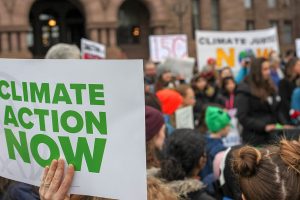
Fridays For Future protest in Toronto, Canada. Photo: Jasmin Sessler
As part of the 2021 Annual Conference, CAA seeks to offer a selection of sessions, papers, speakers, and related programming on the topic of Climate Crisis. Including but going beyond eco-art and eco-criticism, and with climate justice and intersectional thinking as priorities, panels and presentations can address ecology as a matter of the content of artworks, but also, and pressingly, how we—artists, designers, and art historians, institutional stakeholders and independent practitioners, and members of allied fields—can and should change our professional practices in light of the crisis.
We invite discussions of creative interventions into the status quo, up to and including a serious discussion of ways of reducing the carbon footprint of the annual conference itself, while preserving and enhancing access. Practices and themes may include remediation and amelioration, thematic representation and critique, the ramifications of change for institutions and collections, issues of preservation, and the nature of research. We invite radical and practical proposals. The conference content will stress a broad and inclusive conversation on climate crisis impact through the lens of age; gender; nationality; race; religion; and socioeconomic status among others.
CAA’s Services to Artists Committee Presents ARTexchange2020
posted by CAA — January 29, 2020
ARTexchange2020
Workshops • Performances • Exhibition
at Columbia College Chicago, Hokin Gallery, 623 South Wabash
February 12–February 24, 2020
Gallery Hours: Monday–Friday 9:00am–10:00pm; Saturday, 9:00am–5:00pm
Take part in workshops and performances facilitated by artists: Noah Breuer, Wendy DesChene + Jeff Schmuki, Jennifer Natalya Fink & Julie Laffin, Carol Flueckiger, Visda Goudarzi & Artemi-Maria Gioti, MiHyun Kim, Jill Odegaard, Lydia See, Christine Stiver.
View dynamic installations co-created with the public. Visitors can interact with many of the installations even when facilitating artists are not present. Come by every day to see how the space changes. Workshops and events are “drop-in” friendly. You can come and go for any time during facilitated workshops.
CAA’s Services to Artists Committee (SAC), in collaboration with the “Hokin Project,” a gallery management practicum course at Columbia College Chicago, presents ARTexchange 2020 as an opportunity for artists to share their work and build affinities with other artists, historians, curators, cultural producers, and the public.
The exhibition will remain on view through February 24, 2020.
For a full listing of all SAC programming at the 108th CAA conference, see here.
And don’t forget the ARTexchange Reception, Friday, February 14, 7:00pm–8:30pm.
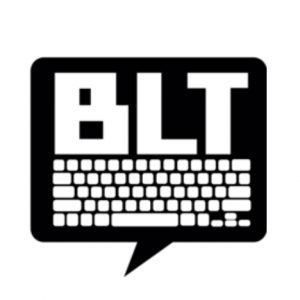
Black Lunch Table — Wikipedia Edit-a-thon
Join us for a Wikipedia edit-a-thon hosted by the Black Lunch Table. Their initiative creates and improves articles about Black visual artists. Celebrating artists of color, women artists, and artists with disabilities, this program supports inclusion and recognition of intersectionality. No prior experience necessary. Bring a computer and a friend!
This programming is partially funded by the Office of Academic Diversity, Equity, and Inclusion, Columbia College Chicago.
Workshop times: Thursday, 10:30am–1:30pm; Friday, 10:30am–1:30pm in the Media Lounge
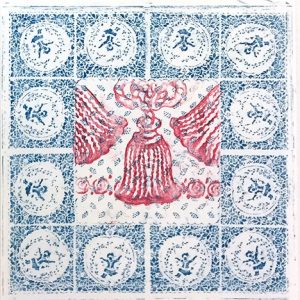
Noah Breuer – CB&S Rubbings and Print Project
Noah Breuer leads a printmaking workshop, utilizing engraved designs inspired by CB&S, his great-great-grandfather’s textile factory that was seized along with all Jewish-owned property in German-occupied areas during WWII. Participants leave with their own book and contribute one copy for visual materials to be built upon by the next participants.
Workshop times: Wednesday, 4:00pm–6:00pm; Thursday, 4:00pm–6:00pm; Friday, 12:00pm–2:00pm
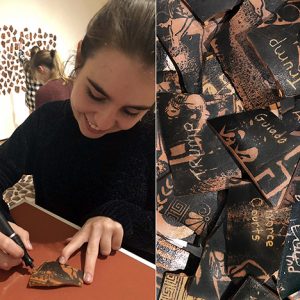
Wendy DesChene + Jeff Schmuki – Ostraka
Join DesChene and Schmuki in celebration of our fundamental right to vote through Ostraka, a collaborative installation that mirrors a 5th-century BC Athenian tradition, where citizens would inscribe the name of a person they wanted to politically neutralize on a shard of broken pottery called an ostrakon.
Workshop times: Wednesday, 2:00pm–4:00pm; Friday, 12:00pm–2:00pm
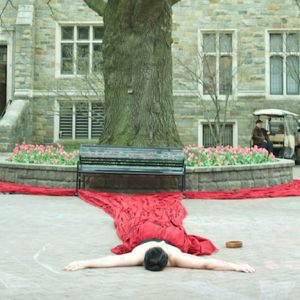
Jennifer Natalya Fink & Julie Laffin – UNDERBELLY
Join artists Fink and Laffin in a performance and “modern suffragette” march, retracing the steps of historical suffrage parades. Airing some dirty laundry to expose the underbelly of the movement, participants will wear two-sided sashes imprinted with both positive and negative statements related to the suffragette movement and voting rights.
Performance time: Thursday, 4:00pm–6:00pm
If you want to be a modern suffragette and participate in the march, sign up here to be contacted by the artists. Meet at the Hokin Gallery at 3:40 pm. Don’t forget to dress weather appropriate.
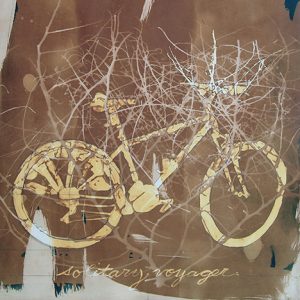
Carol Flueckiger – Solitude of Selfie
Flueckiger’s project explores Elizabeth Cady Stanton’s 19th century women’s suffrage address “Solitude of Self”. Participants will be prompted to engage with Stanton’s speech and make response drawings. Works will be pinned to the wall and later scanned and integrated into a book honoring the 100th anniversary of the 19th amendment.
Workshop times: Wednesday, 9:00am–11:00am; Friday, 9:00am–11:00am
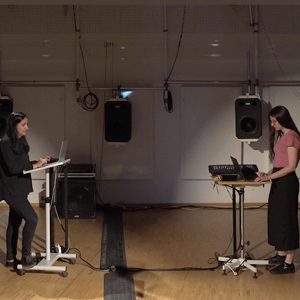
Visda Goudarzi & Artemi-Maria Gioti – Soundsourcing
Soundsourcing is a participatory performance orchestrated by artists Goudarzi and Gioti. In this collaborative sound performance, audience members contribute vocal sounds (words, phonemes and noises) which are picked up by two condenser microphones and processed by laptop performers in real-time. The artists invite participation in this unique sound creation process.
Performance time: Friday, 7:00pm–8:00pm
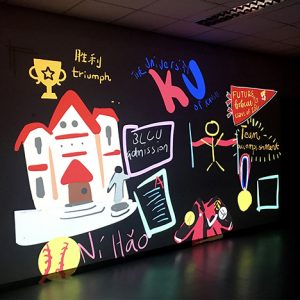
MiHyun Kim – Stories Become Data
Stories Become Data is an interactive digital environment that invites participants to add their own stories to a collective narrative. MiHyun Kim will lead a workshop utilizing iPads and projection to create a space for participants to share and to visualize their stories collectively and simultaneously through real time.
Workshop time: Friday, 2:00pm–4:00pm
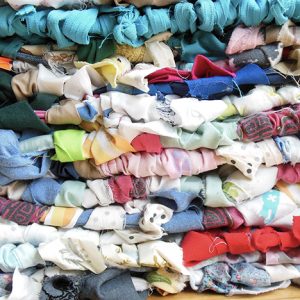
Jill Odegaard – Woven Welcome
Woven Welcome is a community-based art project that utilizes the form of a woven rug as a statement of the interconnectedness of individuals. Join artist Jill Odegaard in creating this artistic metaphor, and engage in a dialogue with other conference attendees and community members.
Workshop times: Wednesday, 6:00pm–10:00pm; Friday, 9:00am–12:00pm
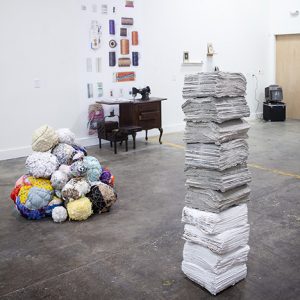
Lydia See – BMC Playbook
Lydia See’s BMC Playbook encourages the examination and manipulation of materials, space, and the collective spirit. This collaborative project, resulting in an installation in the Hokin Gallery, includes a series of chance operations based on a generative BMC card game, inspired by material study workshops at Black Mountain College.
Workshop time: Thursday, 4:00pm–6:00pm
Materials and instructions are available outside facilitated workshop times for the entire exhibition.
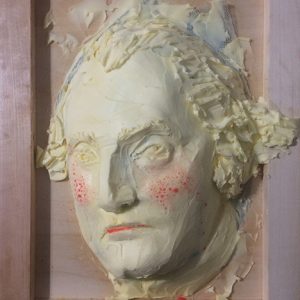
Christine Stiver – Banquet Art
Stiver’s participatory performance Banquet Art is modeled after one of Caroline Shawk Brooks’ own sculpting demonstrations in which she sculpted one face after another on the same bust of butter. Participants will sculpt a series of portraits, starting with Napoleon and George Washington, a litany of “great leaders” will follow.
Workshop time: Friday, 4:00pm–8:00pm
Ongoing
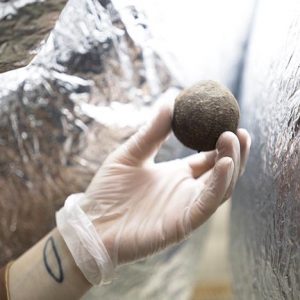
Graduate Student Screenings
A curated selection of current MA/MFA videos/digital artworks, premieres at the Media Lounge Wednesday. Participating artists: ANDiLAND, Jorge Bañales, Andrea Bagdon, Jacklyn Brickman/Heather Taylor, Christian Casas, Danielle Damico, Jesse Egner, Caleb Engstrom, Mary Gring, Selena Ingram, Bibiana Medkova, Carolina Montejo, Strange Lens, Maria V, F. C. Zuke
Call for Submissions: CAA 2020 MFA Screening
posted by CAA — November 20, 2019
CAA’s Services to Artists Committee (SAC) invites MFA students to submit video work for consideration for the upcoming CAA 108th Annual Conference in Chicago in February 2020.
Selected works will be premiered during the conference in the Media Lounge on Wednesday, February 12, 12:15–1:45 PM, and screened during the conference at the ARTexchange exhibition, which will be presented at the Hokin Gallery at Columbia College (623 South Wabash), a half block north of the conference hotel.
Through this screening and exhibition initiative, SAC aims to welcome the next generation of artists and practitioners into our midst. Our annual MFA Screening celebrates the hard work of MFA students across the nation and world, while exposing their artworks to a broad audience. We look forward to reviewing your submissions.
Please use the form here or the button below to submit your entry (a maximum of three per participant).
Deadline: December 10, 2019
Submission for consideration is free, and membership with CAA is not required (we are collecting that information for statistical purposes).
Jurors: Joan Giroux, Richard Serrano, and Vagner Mendonça-Whitehead
Submissions should include the following:
- A short bio (50 words or less)
- A short artist statement (100 words or less)
- A link to 1–3 videos
- Personal website (optional)
Specifics for your submissions:
- 5 minutes in maximum length (excerpts accepted)
- mpeg 4
- 720p
- Slate/Title cards: 5 seconds, with your name, title of work, date of completion, name of school/program
- uploaded onto Vimeo.com (upload your link, allow it to be download-able)
Deadline: December 10, 2019
Acknowledgment: January 15, 2020
In collaboration with the Committee on Women in the Arts, CAA offers 50 percent of the 2020 conference’s content in celebration of the Centennial of Women’s Suffrage in the United States, while also acknowledging the discriminatory practices that limited voting rights for Indigenous women and women of color, even after the passage of the 19th amendment in 1920. The Services to Artists Committee encourages applicants to embrace the spirit of the 2020 conference by engaging issues of inclusivity and intersectional discourses in the arts.
About us: The Services to Artists Committee (SAC) was formed by the CAA Board of Directors to seek broader participation by artists and designers in the organization and the Annual Conference. SAC identifies and addresses concerns facing artists and designers; creates and implements programs and events at the conference and beyond; explores ways to encourage greater participation and leadership in CAA; and identifies ways to establish closer ties with other arts professionals and institutions. To this end, committee members are responsible for the programming of ARTspace and its related events.
Deadline Extended! Participate in ARTexchange at CAA 2020
posted by CAA — October 04, 2019
Originally formatted as a pop-up exhibition and meet-up event for artists and curators, ARTexchange provides an opportunity for artists to share their work and build affinities with other artists, historians, curators, and cultural producers at the Annual Conference.
This year, instead of a one-time event, ARTexchange invites artists to lead participatory projects and/or workshops over the duration of the conference with a culminating public reception on Friday, February 14, from 7-8:30 pm.
CAA’s Services to Artists Committee, in collaboration with the Hokin Project, a gallery management practicum course at Columbia College Chicago, seeks proposals from artists to lead participatory projects and/or workshops for ARTexchange.
ARTexchange projects and/or workshops will take place at the Columbia College Hokin Gallery, from February 12-15, 2020. The gallery is located a half block north of the Hilton Chicago conference hotel at 623 South Wabash. The work created will remain on exhibit through February 24, 2020. Proposals that include community engagement and meaningful interaction with CAA, Columbia College, and Chicago communities will be prioritized.
In collaboration with the Committee on Women in the Arts, CAA offers 50 percent of the 2020 conference’s content in celebration of the Centennial of Women’s Suffrage in the United States, while also acknowledging the discriminatory practices that limited voting rights for Indigenous women and women of color, even after the passage of the 19th amendment in 1920. The Services to Artists Committee encourages applicants to embrace the spirit of the 2020 conference by engaging issues of inclusivity and intersectional discourses in the arts.
Artists will have access to found objects or recycled materials donated and sourced that might include such things as office supplies, paper, fabric, paint, or drawing materials. A risograph with at least eight ink drums is at hand as a possible resource as well. Please consider that activities will take place in a public, open, non-studio environment and should not include toxic materials or processes.
Artists whose proposals are accepted must become CAA members. Complete information on CAA membership is available here.
The Hokin Project is a Gallery Management Practicum course of the Business and Entrepreneurship Department. Graduate and undergraduate students manage all aspects of the gallery to present multi-disciplinary work of the broader Columbia College Chicago community and beyond through programs, events, and exhibitions.
Please email any questions to hokingallery@gmail.com and artexchange2020@gmail.com. Include “CAA ARTexchange” in the subject line.
Deadline to submit (extended): November 8, 2019
- Contact information
- A short narrative bio (150 words or less)
- A short artist statement (150 words or less)
- Website URL (optional)
- A PDF (one file maximum 10 MB) of your proposal detailing your project, including materials requests, technical needs, and how you will engage the community (Chicago, CAA, and Columbia College Chicago) and/or consider inclusivity through the proposal. Please refer to the gallery plan, and if a particular space is preferable for the activity, make a note (please note that space will be shared amongst the accepted projects). If your project might take place over consecutive days, please note below in the Availability section. (up to 500 words)
- Work samples (5–10 images and/or links to 1–2 video/audio files)
- An image description list detailing the title, year completed, medium, and dimensions of each work. You may also include a short description describing how the work relates to the proposed project.
- Availability: your availability during different time slots during the conference and any other information related to scheduling.
Announcing Notable Speakers for 2020 Annual Conference in Chicago
posted by CAA — October 01, 2019
We’re delighted to announce the following guests will be presenting at the 108th CAA Annual Conference, taking place February 12-15, 2020, at the Hilton Chicago.
Keynote Speaker
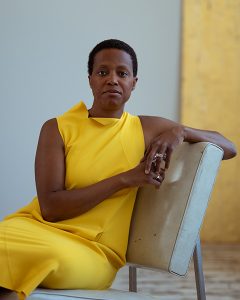
Amanda Williams. Photo: David Kasnic Photography
The Keynote Speaker for the 108th CAA Annual Conference will be Amanda Williams. A visual artist who trained as an architect, Williams’s creative practice navigates the space between art and architecture, through works that employ color as a way to highlight the political complexities of race, place and value in cities. Williams has received critical acclaim including being named a USA Ford Fellow and a Joan Mitchell Foundation grantee. Her works have been exhibited widely and are included in the permanent collections of the Art Institute of Chicago and the Museum of Modern Art in New York. She lives and works on the South Side of Chicago.
CAA Convocation featuring Amanda Williams’s keynote will take place Wednesday, February 12, 2020, from 6-7:30 PM at the Hilton Chicago, Grand Ballroom. Free and open to the public.
Distinguished Scholar
The Distinguished Scholar for the 108th CAA Annual Conference will be Dr. Kellie Jones, professor in Art History and Archaeology and African American and African Diaspora Studies at Columbia University. Her research interests include African American and African Diaspora artists, Latinx and Latin American Artists, and issues in contemporary art and museum theory.
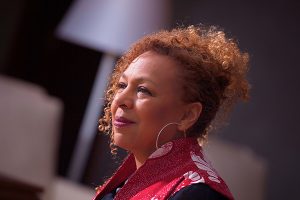
Dr. Kellie Jones. Photo: Rod McGaha
Dr. Jones, a member of the American Academy of Arts and Sciences, has also received awards for her work from the Hutchins Center for African and African American Research, Harvard University and Creative Capital | Warhol Foundation. In 2016 she was named a MacArthur Foundation Fellow.
Dr. Jones’s writings have appeared in a multitude of exhibition catalogues and journals. She is the author of two books published by Duke University Press, EyeMinded: Living and Writing Contemporary Art (2011), and South of Pico: African American Artists in Los Angeles in the 1960s and 1970s (2017), which received the Walter & Lillian Lowenfels Criticism Award from the American Book Award in 2018 and was named a Best Art Book of 2017 in The New York Times and a Best Book of 2017 in Artforum.
Dr. Jones has also worked as a curator for over three decades and has numerous major national and international exhibitions to her credit. Her exhibition “Now Dig This! Art and Black Los Angeles, 1960-1980,” at the Hammer Museum, Los Angeles, was named one of the best exhibitions of 2011 and 2012 by Artforum, and best thematic show nationally by the International Association of Art Critics (AICA). She was co-curator of “Witness: Art and Civil Rights in the 1960s” (Brooklyn Museum), named one the best exhibitions of 2014 by Artforum. Read our interview with Kellie Jones.
The Distinguished Scholar Session will take place Thursday, February 13, 2020, from 4-5:30 PM at the Hilton Chicago, Grand Ballroom.
Distinguished Artist Interviews
The Distinguished Artist Interviews will feature artist Sheila Pepe interviewed by John Corso Esquivel, and artist Arnold J. Kemp interviewed by Huey Copeland.
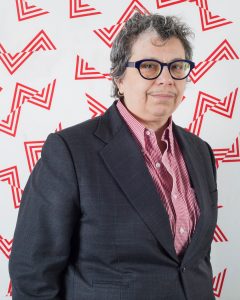
Sheila Pepe. Photo: Rachel Stern
Sheila Pepe is a cross-disciplinary artist employing conceptualism, surrealism, and craft to address feminist and class issues. Hot Mess Formalism, Pepe’s most recent solo exhibition organized by the Phoenix Art Museum, traveled to the Everson Museum of Art, Syracuse, New York; Bemis Center for Contemporary Arts, Omaha, Nebraska; and the deCordova Sculpture Park and Museum, Lincoln, Massachusetts between 2017 and 2019. A catalogue for the exhibition featured essays by by Julia Bryan-Wilson, Elizabeth Dunbar, Lia Gangitano, and curator Gilbert Vicario.
Other texts, all published in 2019, feature Pepe’s work: Vitamin T: Threads, and Textiles in Contemporary Art, the revised Art and Queer Culture by Catherine Lord and Richard Meyer, both published by Phaidon, and Feminist Subjectivities in Fiber Art and Craft: Shadows of Affect by John Corso Esquivel.
Venues for Pepe’s many other solo exhibitions include the Smith College Museum of Art, Northampton, Massachusetts, and the Weatherspoon Art Museum, Greensboro, North Carolina. Her work has been included in important group exhibitions, most recently Fiber: Sculpture 1960- Present, curated by Janelle Porter, organized by the ICA Boston; Queer Abstraction, curated by Jared Ladesema, organized by the Des Moines Art Center in Iowa and Even Thread Has Speech, curated by Shannon Stratton for the John Michael Kohler Art Center, Wisconsin.
John Corso Esquivel is the Doris and Paul Travis Associate Professor of Art History at Oakland University.

Arnold J. Kemp. Photo: Todd Rosenberg for the School of the Art Institute of Chicago
Arnold J. Kemp is an interdisciplinary artist living in Chicago. The recurrent theme in his drawings, photographs, sculptures and writing is the permeability of the border between self and the materials of one’s reality. Kemp’s works are in the collections of the Metropolitan Museum of Art, The Studio Museum in Harlem, The Berkeley Art Museum and Pacific Film Archive, The Portland Art Museum, The Schneider Museum of Art, and the Tacoma Art Museum. He has received awards from the John Simon Guggenheim Memorial Foundation, the Joan Mitchell Foundation, The Pollock-Krasner Foundation, and Portland Institute for Contemporary Art. His work has been exhibited recently in Chicago, Mexico City, New York, San Francisco and Portland. His work was also shown in Tag: Proposals On Queer Play and the Ways Forward at the ICA Philadelphia. Kemp was a founding curator at Yerba Buena Center for the Arts from 1993-2003 and is currently the Dean of Graduate Studies at the School of the Art Institute of Chicago. Read our interview with Arnold J. Kemp.
Huey Copeland is Arthur Andersen Teaching and Research Professor, Interim Director of the Black Arts Initiative (2019-2020), Associate Professor of Art History, and affiliated faculty in the Critical Theory Cluster, the Department of African American Studies, the Department of Art Theory & Practice, the Department of Performance Studies, and the Gender and Sexuality Studies Program at Northwestern University.
The Distinguished Artist Interviews will take place Friday, February 14, 2019, from 4-6:30 PM at the Hilton Chicago, Grand Ballroom. Free and open to the public.




